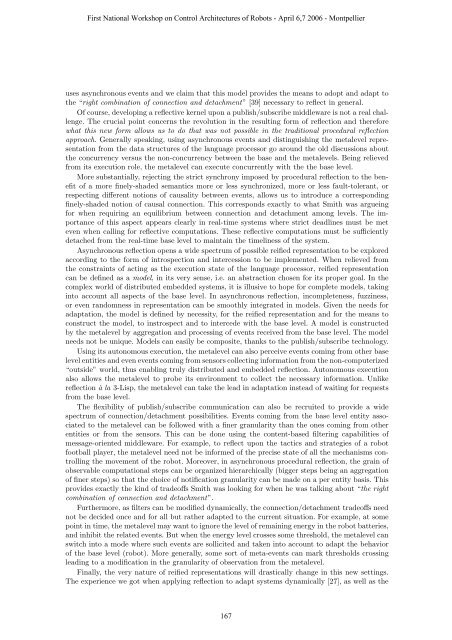Pleading for open modular architectures - Lirmm
Pleading for open modular architectures - Lirmm
Pleading for open modular architectures - Lirmm
Create successful ePaper yourself
Turn your PDF publications into a flip-book with our unique Google optimized e-Paper software.
First National Workshop on Control Architectures of Robots - April 6,7 2006 - Montpellier<br />
uses asynchronous events and we claim that this model provides the means to adopt and adapt to<br />
the “right combination of connection and detachment” [39] necessary to reflect in general.<br />
Of course, developing a reflective kernel upon a publish/subscribe middleware is not a real challenge.<br />
The crucial point concerns the revolution in the resulting <strong>for</strong>m of reflection and there<strong>for</strong>e<br />
what this new <strong>for</strong>m allows us to do that was not possible in the traditional procedural reflection<br />
approach. Generally speaking, using asynchronous events and distinguishing the metalevel representation<br />
from the data structures of the language processor go around the old discussions about<br />
the concurrency versus the non-concurrency between the base and the metalevels. Being relieved<br />
from its execution role, the metalevel can execute concurrently with the the base level.<br />
More substantially, rejecting the strict synchrony imposed by procedural reflection to the benefit<br />
of a more finely-shaded semantics more or less synchronized, more or less fault-tolerant, or<br />
respecting different notions of causality between events, allows us to introduce a corresponding<br />
finely-shaded notion of causal connection. This corresponds exactly to what Smith was argueing<br />
<strong>for</strong> when requiring an equilibrium between connection and detachment among levels. The importance<br />
of this aspect appears clearly in real-time systems where strict deadlines must be met<br />
even when calling <strong>for</strong> reflective computations. These reflective computations must be sufficiently<br />
detached from the real-time base level to maintain the timeliness of the system.<br />
Asynchronous reflection <strong>open</strong>s a wide spectrum of possible reified representation to be explored<br />
according to the <strong>for</strong>m of introspection and intercession to be implemented. When relieved from<br />
the constraints of acting as the execution state of the language processor, reified representation<br />
can be defined as a model, in its very sense, i.e. an abstraction chosen <strong>for</strong> its proper goal. In the<br />
complex world of distributed embedded systems, it is illusive to hope <strong>for</strong> complete models, taking<br />
into account all aspects of the base level. In asynchronous reflection, incompleteness, fuzziness,<br />
or even randomness in representation can be smoothly integrated in models. Given the needs <strong>for</strong><br />
adaptation, the model is defined by necessity, <strong>for</strong> the reified representation and <strong>for</strong> the means to<br />
construct the model, to instrospect and to intercede with the base level. A model is constructed<br />
by the metalevel by aggregation and processing of events received from the base level. The model<br />
needs not be unique. Models can easily be composite, thanks to the publish/subscribe technology.<br />
Using its autonomous execution, the metalevel can also perceive events coming from other base<br />
level entities and even events coming from sensors collecting in<strong>for</strong>mation from the non-computerized<br />
“outside” world, thus enabling truly distributed and embedded reflection. Autonomous execution<br />
also allows the metalevel to probe its environment to collect the necessary in<strong>for</strong>mation. Unlike<br />
reflection à la 3-Lisp, the metalevel can take the lead in adaptation instead of waiting <strong>for</strong> requests<br />
from the base level.<br />
The flexibility of publish/subscribe communication can also be recruited to provide a wide<br />
spectrum of connection/detachment possibilities. Events coming from the base level entity associated<br />
to the metalevel can be followed with a finer granularity than the ones coming from other<br />
entities or from the sensors. This can be done using the content-based filtering capabilities of<br />
message-oriented middleware. For example, to reflect upon the tactics and strategies of a robot<br />
football player, the metalevel need not be in<strong>for</strong>med of the precise state of all the mechanisms controlling<br />
the movement of the robot. Moreover, in asynchronous procedural reflection, the grain of<br />
observable computational steps can be organized hierarchically (bigger steps being an aggregation<br />
of finer steps) so that the choice of notification granularity can be made on a per entity basis. This<br />
provides exactly the kind of tradeoffs Smith was looking <strong>for</strong> when he was talking about “the right<br />
combination of connection and detachment”.<br />
Furthermore, as filters can be modified dynamically, the connection/detachment tradeoffs need<br />
not be decided once and <strong>for</strong> all but rather adapted to the current situation. For example, at some<br />
point in time, the metalevel may want to ignore the level of remaining energy in the robot batteries,<br />
and inhibit the related events. But when the energy level crosses some threshold, the metalevel can<br />
switch into a mode where such events are sollicited and taken into account to adapt the behavior<br />
of the base level (robot). More generally, some sort of meta-events can mark thresholds crossing<br />
leading to a modification in the granularity of observation from the metalevel.<br />
Finally, the very nature of reified representations will drastically change in this new settings.<br />
The experience we got when applying reflection to adapt systems dynamically [27], as well as the<br />
167

















